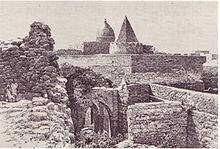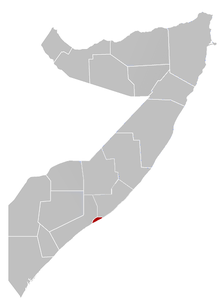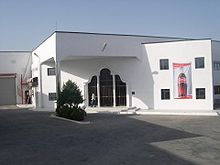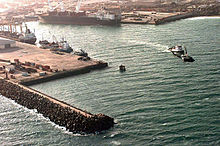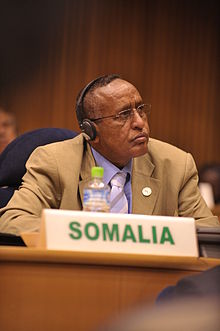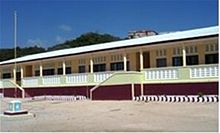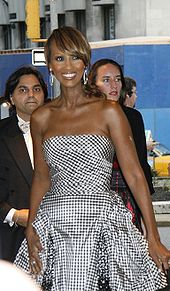- Mogadishu
-
Mogadishu
مقديشو MaqadīshūNickname(s): Xamar,[1] The Mog, Mog[2] Location in Somalia. Coordinates: 2°02′N 45°21′E / 2.033°N 45.35°ECoordinates: 2°02′N 45°21′E / 2.033°N 45.35°E Country  Somalia
SomaliaRegion Benadir Government[3] – Mayor Mohamed Nur Population (2006)[4] – Total 2,000,000 Time zone EAT (UTC+2) Mogadishu (
 /ˌmɒɡəˈdɪʃuː/; Somali: Muqdisho; Arabic: مقديشو Maqadīshū; Italian: Mogadiscio, literally "The Seat of the Shah"), popularly known as Xamar,[1] is the largest city in Somalia and the nation's capital. Located in the coastal Benadir region on the Indian Ocean, the city has served as an important port for centuries.
/ˌmɒɡəˈdɪʃuː/; Somali: Muqdisho; Arabic: مقديشو Maqadīshū; Italian: Mogadiscio, literally "The Seat of the Shah"), popularly known as Xamar,[1] is the largest city in Somalia and the nation's capital. Located in the coastal Benadir region on the Indian Ocean, the city has served as an important port for centuries.Tradition and old records assert that southern Somalia, including the Mogadishu area, was historically inhabited by hunter-gatherers of Bushman physical stock. These were later joined by Cushitic agro-pastoralists, who would go on to establish local aristocracies.[5] Starting in the late 9th or 10th centuries, Arab and Persian traders also began to settle in the region.[6]
During its medieval Golden Age, Mogadishu was ruled by the Somali-Arab Muzaffar dynasty, a vassal of the Ajuuraan State.[7] It subsequently fell under the control of an assortment of local Sultanates and polities, most notably the Gobroon Dynasty.[8] The city later became the capital of Italian Somaliland in the colonial period.
After the ousting of the Siad Barre regime and the ensuing civil war, various militias fought for control of the city, later to be replaced by the Islamic Courts Union. The ICU subsequently splintered into more radical groups, notably Al Shabaab, which have since been fighting the Transitional Federal Government and its AMISOM allies. With a change in administration in late 2010, federal control of Mogadishu steadily expanded. The pace of territorial gains also greatly accelerated, as more trained government and AMISOM troops entered the city. In early August 2011, government troops and their AMISOM partners had reportedly succeeded in forcing out Al-Shabaab from the parts of the city that the group had previously controlled.[9]
Contents
Etymology
The name "Mogadishu" is held to be derived from the Persian مقعد شاه Maq'ad-i-Shah ("The seat of the Shah"), a reflection of the city's early Persian influence.[10]
History
Early history
Tradition and old records assert that southern Somalia, including the Mogadishu area, was inhabited in early historic times by hunter-gatherers of Bushman stock. Although most of these early inhabitants are believed to have been either overwhelmed, driven away or, in some cases, assimilated by later migrants to the area, physical traces of their occupation survive in certain ethnic minority groups inhabiting modern-day Jubaland and other parts of the south. The latter descendants include relict populations such as the Eile, the Wa-Ribi, and especially the Wa-Boni.[11][5] By the time of the arrival of peoples from the Cushitic Rahanweyn or Digil and Mirifle clan confederacy, who would go on to establish a local aristocracy, other Cushitic groups affiliated with the Oromo (Wardai) and Ajuuraan (Ma'adanle) had already formed settlements of their own in the sub-region.[11][5]
According to the Periplus of the Erythraean Sea, a Greek travel document dating from the turn of the Common Era, maritime trade already connected peoples in the Mogadishu area with other communities along the Indian Ocean coast.
The Sultanate of Mogadishu later developed with the immigration of Emozeidi Arabs, a community whose earliest presence dates back to the 9th or 10th century.[6] This evolved into the Muzaffar dynasty, a joint Somali-Arab federation of rulers, and Mogadishu became closely linked with the powerful Somali Ajuuraan State.[7]
Following his visit to the city, the 12th century Syrian historian Yaqut al-Hamawi wrote that it was inhabited by dark-skinned Berbers, the ancestors of the modern Somalis.[12][13]
For many years, Mogadishu stood as the pre-eminent city in the بلاد البربر Bilad-ul-Barbar ("Land of the Berbers"), which was the medieval Arabic term for the Horn of Africa.[14][15][16]
By the time of the Moroccan traveller Ibn Battuta's appearance on the Somali coast in 1331, the city was at the zenith of its prosperity. Battuta described Mogadishu as "an exceedingly large city" with many rich merchants, which was famous for its high quality fabric that it exported to Egypt, among other places.[17][18] He added that the city was ruled by a Somali Sultan originally from Berbera in northern Somalia who spoke both Somali (referred to by Battuta as Mogadishan, the Benadir dialect of Somali) and Arabic with equal fluency.[19][20] The Sultan also had a retinue of wazirs (ministers), legal experts, commanders, royal eunuchs, and other officials at his beck and call.[19]
The Portuguese would later attempt to occupy the city, but never managed to take it. The Hawiye Somali, however, were successful in defeating the Ajuuraan State and bringing about the end of Muzaffar rule.[7]
1800s-1950s
By 1892, Mogadishu was under the joint control of the Somali Geledi Sultanate (which, also holding sway over the Shebelle region in the interior, was at the height of its power) and the Arab Sultan of Zanzibar.[8]
In 1892, Ali bin Said leased the city to Italy. Italy purchased the city in 1905 and made Mogadishu the capital of the newly-established Italian Somaliland. After World War I, the surrounding territory came under Italian control with some resistance.
Thousands of Italian colonists moved to live in Mogadishu and founded small manufacturing companies. They also developed some agricultural areas around the capital such as the Villaggio duca degli Abruzzi and the Genale.[21]
In the 1930s, new buildings and avenues were built. A 114 km narrow-gauge railway was laid from Mogadishu to Jowhar, then called "Villaggio Duca degli Abruzzi". An asphalted road, the Strada Imperiale, was also constructed, intended to link Mogadishu to Addis Ababa.
Mogadishu remained the capital of Italian Somaliland throughout the existence of the latter, and became the capital of independent Somalia in 1960.
Modern history
Main articles: Somali Civil War, Battle of Mogadishu (1993), Battle of Mogadishu (2006), Fall of Mogadishu, Battle of Mogadishu (March–April 2007), Battle of Mogadishu (November 2007), Battle of Mogadishu (2008), Battle of South Mogadishu, Battle of Mogadishu (2009), and Battle of Mogadishu (2010)Rebel forces entered and took the city in 1990, forcing the then President of Somalia, Mohamed Siad Barre, to flee in 1991 to Kenya. One faction proclaimed Ali Mahdi Muhammad president, another Mohamed Farrah Aidid. A contingent of United States Marines landed near Mogadishu on December 9, 1992 to spearhead the United Nations peacekeeping forces during Operation Restore Hope, in which Pakistan, Italy and Malaysia also participated.
Following Operation Restore Hope, tension escalated when militia loyal to warlord Mohamed Farrah Aidid attacked Pakistani peacekeeping troops, killing 24 soldiers. In response, the US deployed Task Force Ranger, a contingent of US special operations forces, including Army Rangers, Delta operators, and specialized aviation units to Somalia. Their mission was to capture or kill Aidid and dismantle his clan leadership structure. The operation culminated in a fierce street battle between SNA militia and US soldiers on October 3-4, 1993. During the battle, SNA soldiers successfully shot down two US Army MH-60 Black Hawk helicopters which crashed within the Aidid-controlled sections of the city. The Rangers immediately secured one of the crash sites and held off the attacking SNA forces through the night while awaiting support from a UN armored convoy which arrived the following morning. During the battle, 18 U.S. soldiers died and 73 were injured. The Malaysian forces lost one soldier and had seven injured, while the Pakistanis suffered two injured. Casualties on the Somali side were heavy, with estimates on fatalities ranging from 500 to over 2,000 people. The Somali casualties were a mixture of SNA forces, clan militia, and local civilians, many of whom took up arms against the US forces. After the battle, one or more US casualties of the conflict were dragged through the streets of Mogadishu by crowds of local civilians and SNA forces. Two days later, a mortar round fell on the U.S. compound, killing one U.S. soldier, and injuring another twelve.
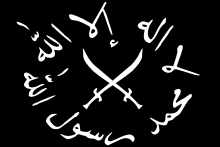 Flag of al-Shabaab, Somalia's most prominent rebel group since the collapse of the Islamic Courts Union.
Flag of al-Shabaab, Somalia's most prominent rebel group since the collapse of the Islamic Courts Union.
Mogadishu was subsequently run by competing warlords until 2006, when Islamists and businessmen formed a successful coalition government, which came to be known as the Islamic Courts Union (ICU). The ICU seized control of the entire country, except for the town of Baidoa, which was held by the Transitional Federal Government, the internationally recognized government of Somalia. Later that same year, the Ethiopian military ousted the ICU and restored the internationally-recognized government,[22] which had long remained in exile in Kenya, with Baidoa being its only Somali foothold.
Mogadishu was the scene of bitter warfare and devastation caused by fighting between Ethiopian and Somali government troops, and Islamist guerrillas. Fighting escalated in March–April 2007, November 2007 and April 2008 with hundreds of civilian casualties. In October 2008, the BBC reported that the city had been "abandoned by at least half of its residents", and that there were "street after ruined street of bombed-out buildings in the center of Mogadishu".[22]
As of 2008, a 2,700-strong African Union peacekeeping force is attempting to bring stability and security to the city,[22] as well as providing medical aid to the population.[23]
Since May 8, 2009, there has been an increase in violence reportedly leading to the displacement of more than 165,000 of the inhabitants. The violence has culminated in several suicide bomb attacks, normally rare occurrences in Somalia.[24][25][26] The attacks have claimed many lives, amongst them Mohamed Hussein Addow, a legislative politician and the third high-profile public killing in as many days throughout the country.[27]
During the holy month of Ramadan in 2010, Al-Shabaab militants launched one of their largest offensives ever. The Transitional Federal Government's troops and their AMISOM allies managed to successfully fend off the attack, marking the turning of the tide for battle of control over the city.[28] A new government was subsequently elected in November of the year, which, in its first 50 days in power, has managed to make steady gains in territory. By May 2011, the TFG and its AMISOM allies managed to secure control of 60% of Mogadishu,[29] where 80% of the city's population now lives.[30] With almost a thousand newly-trained government troops, augmented by an additional 4000 AMISOM soldiers, the pace of territorial gains greatly accelerated.[30] In early August 2011, after two weeks of heavy fighting, government troops and their AMISOM partners had reportedly succeeded in forcing out Al-Shabaab insurgents from the parts of the city that the militants had previously controlled.[9]
Ethnic groups
Mogadishu is a multi-ethnic city. Its original core population consisted of Bushmen aboriginals, and later Cushitic, Arab and Persian migrants.[5][6] During the Arab slave trade, many Bantu peoples were brought in for agricultural work from the market in Zanzibar. The mixture of these various groups produced the Benadiri or Reer Xamar (“People of Mogadishu”), a composite population unique to the larger Benadir region.[31] In the colonial period, European expatriates, primarily Italians, would also contribute to the city's cosmopolitan populace.
The main area of inhabitation of Bantu ethnic minorities in Somalia has historically been in village enclaves in the south; particularly between the Jubba and Shebelle river valleys as well as the Bakool and Bay regions, though a few subsisting as fishermen could also be found in areas further north. Beginning in the 1970s, more Bantus began moving to urban centers such as Mogadishu and Kismayo.[32] By the late 1980s, over 40 percent of Mogadishu's population consisted of individuals from ethnic minority groups.[33] The displacement caused by the onset of the civil war in the 1990s further increased the number of rural Bantu migrating to urban areas. As a consequence of these movements, Mogadishu's traditional demographic makeup has changed significantly over the years.[32]
Geography
Mogadishu is located at 2°4′N 45°22′E / 2.067°N 45.367°E. The Shebelle River (Webiga Shabelle) rises in central Ethiopia and comes within 30 kilometers (19 mi) of the Indian Ocean near Mogadishu before turning southwestward. Usually dry during February and March, the river provides water essential for the cultivation of sugarcane, cotton, and bananas.
Features of the city include the Hamarwein old town, the Bakaara Market, and the former resort of Gezira Beach. The sandy beaches of Mogadishu are reported by the few Western travelers to be among the most beautiful in the world, offering easy access to vibrant coral reefs.[34]
Administrative divisions
Mogadishu is situated in Banaadir, an administrative region (gobolka) in southeastern Somalia.[35] The region itself is coextensive with the city and is much smaller than the historical province of Benadir.
Mogadishu is thus officially divided into fourteen administrative districts:[36]
- Abdiaziz District
- Bondhere District
- Dharkenley District
- Hamar-Jajab District
- Hamar-Weyne District
- Hodan District
- Howl-Wadag District
- Kaaraan District
- Shangaani District
- Shibis District
- Waabari District
- Wadajir District
- Wardhiigley District
- Yaaqshiid District
Climate
For a city situated so near the equator, Mogadishu has a dry climate. It is classified as hot and semi-arid (Köppen climate classification BSh). Much of the land the city lies upon is desert terrain. The city has a low annual rainfall of 427mm, most which falls in the wet season. The rains are very variable from year to year, and drought is a constant problem for the people living in Somalia.
Sunshine is abundant in the city, averaging eight to ten hours a day year-round. It is lowest during the wet season, when there is some coastal fog and greater cloud coverage as warm air passes over the cool sea surface.
Climate data for Mogadishu Month Jan Feb Mar Apr May Jun Jul Aug Sep Oct Nov Dec Year Record high °C (°F) 34
(93)32
(90)33
(91)36
(97)34
(93)32
(90)32
(90)30
(86)32
(90)32
(90)32
(90)34
(93)36
(97)Average high °C (°F) 30
(86)30
(86)31
(88)32
(90)32
(90)29
(84)28
(82)28
(82)29
(84)30
(86)31
(88)30
(86)30 Average low °C (°F) 23
(73)23
(73)24
(75)26
(79)25
(77)23
(73)23
(73)23
(73)23
(73)24
(75)24
(75)24
(75)24 Record low °C (°F) 20
(68)18
(64)20
(68)20
(68)18
(64)20
(68)15
(59)16
(61)18
(64)18
(64)21
(70)20
(68)15
(59)Precipitation mm (inches) 0
(0)0
(0)0
(0)58
(2.28)58
(2.28)97
(3.82)64
(2.52)48
(1.89)25
(0.98)23
(0.91)41
(1.61)13
(0.51)427
(16.81)Source: BBC Weather [37] Economy
Mogadishu traditionally served as a commercial and financial center. Before the introduction of mass-produced cloth from Europe and America, the textiles of Mogadishu were forwarded far and wide throughout the interior of the continent, as well as to Arabia and even as far as the Persian coast.[38]
The economy has recovered somewhat from the civil unrest, faring relatively better than other Somali cities,[39] although the Somali Civil War still presents many problems. Hotels and other businesses have hired private security militias to provide protection and ensure the normal course of business.[40]
Principal industries include food and beverage processing and textiles, especially cotton ginning. The main market offers goods from food to electronic gadgets.
Hormuud Telecom, the largest telecommunications company in southern and central Somalia, has its headquarters in Mogadishu. Telcom is another telecommunications service provider based in the city.
Jubba Airways has its head office in Mogadishu.[41]
Transportation
Road
Roads leading out of Mogadishu connect the city to other localities in Somalia and to Ethiopia and Kenya. The city itself is cut into a several grid layouts by an extensive road network. Due to neglect brought on by the protracted civil war, there are few paved roads, but numerous unpaved and back streets throughout the city.[42] The roads support the flow of both vehicular and pedestrian traffic. With the ouster of the Al-Shabaab rebels from the city in mid 2011, large-scale rehabilitation of roads and general infrastructure has begun.[43]
Air
During the post-independence period, Mogadishu International Airport offered flights to numerous global destinations.[44] In the mid-1960s, the airport was enlarged to accommodate more international carriers, with the state-owned Somali Airlines providing regular trips to all major cities.[45] By 1969, the airport's many landing grounds could also host small jets and DC 6B-type aircraft.[44]
The facility grew considerably in size in the post-independence period after numerous successive renovation projects. With the outbreak of the civil war in the early 1990s, Mogadishu International Airport's flight services experienced routine disruptions and its grounds and equipment were largely destroyed. In the late 2000s, the K50 Airport, situated 50 kilometers south of the capital, served as the capital's main airport while Mogadishu International Airport, now renamed Aden Adde International Airport, briefly shut down.[46] However, in the late 2010 period, the security situation in Mogadishu had significantly improved, with the federal government eventually managing to assume full control of the city by August of the following year.[9]
In late 2010, SKA Air and Logistics, a Dubai-based aviation firm that specializes in conflict zones, was contracted by Somalia's Transitional Federal Government to manage operations over a period of ten years at the re-opened Aden Adde International Airport. With concurrent activities in Iraq and Afghanistan, among other complex areas, the company is expected to run security screening, passenger security and terminals. SKA staff has also begun re-training Somalian airport personnel for the purpose. Although flights and other airport operations are presently limited to daylight hours, the firm is working on expanding activities once runway lighting and other features have been restored.[47]
As of 2011, the largest services using Adden Adde International Airport include the Somali-owned private carriers Jubba Airways and Daallo Airlines, in addition to UN charter planes and African Express Airways.[47] The airport also offers flights to other Somalian cities such as Galkacyo, Berbera and Hargeisa, as well as international destinations like Djibouti and Jeddah.[48]
Sea
Mogadishu leads Somalia in port traffic and still serves as a major seaport. While daily shipments bring in vehicles, foodstuffs and electronic goods, among other items, the port's monthly tax revenue never exceeded $900,000 due to kickbacks. In 2010, a new government was appointed to office, which then re-shuffled the port authority's staff. Monthly revenue from the city's port subsequently rose to a record $2.5 million.[49]
Railway
There were projects during the 1980s to reactivate the 114 km railway between Mogadishu and Jowhar, built by the Italians in 1926 but dismantled in World War II by British troops. The Mogadishu-Villabruzzi Railway was planned in 1939 to reach Addis Ababa.
Government
Federal
With a newly-elected technocratic administration and a significant increase in troop strength, the federal government is steadily expanding its influence in Mogadishu.[30]
The Transitional Federal Government (TFG) is the current internationally recognized federal government of Somalia. Based in Mogadishu, it constitutes the executive branch of government.
In November 2010, a new technocratic government was elected to office. In its first 50 days in office, the new administration completed its first monthly payment of stipends to government soldiers, and initiated the implementation of a full biometric register for the security forces within a window of four months. Additional members of the Independent Constitutional Commission were also appointed to engage Somali constitutional lawyers, religious scholars and experts in Somali culture over the nation's upcoming new constitution, a key part of the government's Transitional Federal Tasks. In addition, high level federal delegations were dispatched to defuse clan-related tensions in several regions.[30]
To improve transparency, Cabinet ministers fully disclosed their assets and signed a code of ethics. An Anti-Corruption Commission with the power to carry out formal investigations and to review government decisions and protocols was also established so as to more closely monitor all activities by public officials. Furthermore, unnecessary trips abroad by members of government were prohibited, and all travel by ministers now require the Premier’s consent.[30][50] A budget outlining 2011’s federal expenditures was also put before and approved by members of parliament, with the payment of civil service employees prioritized. In addition, a full audit of government property and vehicles is being put into place.[30]
The Transitional Federal Government continues to reach out to both Somali and international stakeholders to help grow the administrative capacity of the Transitional Federal Institutions and to work toward eventual national elections in 2011, when the interim government's mandate expires.[30][40]
Municipal
Mogadishu's municipal government is currently led by Mayor Mohamed Nur, a former Labour Party member and business advisor to Islington Council in London. Since taking office in 2010, Nur's administration has enacted a number of reforms in a bid to improve the city's security and service delivery, including starting a garbage collection program, erecting proper streetlights and providing around-the-clock electricity, sacking corrupt public officials, and offering formal police protection. The municipal government has also firmed up on traffic safety, fining motorists who drive without lights, in the wrong street lanes or carrying excessive loads.[51]
Education
Despite the civil unrest, Mogadishu counts several institutions of higher learning. Mogadishu University (MU) is a non-governmental university that is governed by a Board of Trustees and a University Council. It is the brainchild of a number of professors from the Somali National University as well as other Somali intellectuals who sought to find ways to provide post-secondary education in the wake of the civil war. Financed by the Islamic Development Bank in Jeddah, Saudi Arabia, as well as other donor institutions, the university counts hundreds of young Somali graduates from its seven faculties, some of whom continue on to pursue Master's degrees abroad thanks to a scholarship program. Mogadishu University has established partnerships with several other academic institutions, including the University of Aalborg in Denmark, three universities in Egypt, seven universities in Sudan, the University of Djibouti, and two universities in Yemen. It has also been scored among the 100 best universities in Africa in spite of the harsh environment, which has been hailed as a triumph for grass-roots initiatives.[52]
The Somali National University, founded in 1954 during the "Italian Trust Administration of Somalia" (AFIS), has been closed indefinitely due to extensive damage.
Benadir University (BU) was established in 2002 with the intention of training doctors. It has since expanded into other fields.
Due to human capital shortage in the country's private sector management, the Somali Institute of Management and Administration Development (SIMAD) has given priority to the fields of business administration, information technology and accountancy.
Culture
Media
There are a number of radio news agencies based in Mogadishu. These include HornAfrik and the Shabelle Media Network, the latter of which was in 2010 awarded the Media of the Year prize by the Paris-based journalism organisation, Reporters Without Borders (RSF), despite facing considerable pressure and harassment from the local militias.[53] The government-run station Radio Mogadishu also operates out of the city, as does the Somali National Television network.
Sports
The city is home to Mogadishu Stadium, which plays host to the Somalia Cup and to football teams from the Somalia League. The New Somali Youth League grassroots organization based in Mogadishu has also started the Swap Gun for Job and Sports Campaign aimed at discouraging youngsters in the city from engaging in vice by offering them employment opportunities and sporting activities.[54]
Music
Somali popular music enjoys a large audience in Mogadishu, and until recently, was widely sold.[55] However, as the Islamist extremists gained control of parts of the city, they promptly banned all such music and forbade radio stations from playing it.[56] The Transitional Federal Government has condemned this and other draconian edicts,[57] and has worked to restore civil liberties as it steadily expands its control of Mogadishu. Most of the city's population has in turn responded by moving to government-controlled areas.[30] On the 6th August 2011 it was reported that Al-Shabab had withdrawn from the parts of Mogadishu that it controlled, as a "strategic withdrawal" in preparation for a "counterattack".[58]
Notable Mogadishans
- Ayub Daud, professional footballer
- Fatima Siad, fashion model
- Hassan Abshir Farah, former Prime Minister of Somalia and Mayor of Mogadishu
- Ali Mohammed Ghedi, former Prime Minister of Somalia
- Iman, supermodel
- K'naan, award-winning musician
- Mo Farah, international track and field athlete
- Mustafa Mohamed, professional athlete
- Omar Abdirashid Ali Sharmarke, former Prime Minister of Somalia
- Rageh Omaar, award-winning journalist
- Mohamed Abdullahi Mohamed, former Prime Minister of Somalia
- Saba Anglana, international singer and actress
- Yasmin Warsame, supermodel
- Zahra Bani, professional athlete
- Shaykh Sufi, 19th century scholar, poet, reformist and astrologist
- Sa'id of Mogadishu, 14th century Islamic scholar and traveler
References
- ^ a b Encyclopaedia Britannica, inc, The New Encyclopaedia Britannica: Marcopædia, Volume 17, (Encyclopædia Britannica: 1991), p.829.
- ^ Fred Oluoch (2010-01-10). "Somalia: A Working Christmas in Mogadishu". allAfrica.com. http://allafrica.com/stories/201001111508.html. Retrieved 2011-10-12.
- ^ John Pike (2007-08-13). "SOMALIA: Conditions worsen in camps as thousands more flee Mogadishu". Globalsecurity.org. http://www.globalsecurity.org/military/library/news/2007/08/mil-070813-irin02.htm. Retrieved 2011-06-12.
- ^ "Somalia". IAED. http://www.iaed.org/somalia/. Retrieved 2011-06-12.
- ^ a b c d Ireland, Royal Anthropological Institute of Great Britain and; (Organization), Jstor (1953). "Man". Man 53: 50–51. http://books.google.ca/books?id=paURAAAAIAAJ. Retrieved 11 August 2011.
- ^ a b c I.M. Lewis, Peoples of the Horn of Africa: Somali, Afar, and Saho, Issue 1, (International African Institute: 1955), p.47
- ^ a b c I.M. Lewis, The modern history of Somaliland: from nation to state, (Weidenfeld & Nicolson: 1965), p. 37
- ^ a b I. M. Lewis, A modern history of Somalia: nation and state in the Horn of Africa, (Westview Press: 1988), p.38
- ^ a b c Al-Shabaab ‘dug in like rats’
- ^ David D. Laitin, Said S. Samatar, Somalia: Nation in Search of a State, (Westview Press: 1987), p. 12.
- ^ a b Oliver, Roland Anthony; J. D. Fage (1960). "The Journal of African history". The Journal of African history 1: 216. http://books.google.ca/books?id=4SPjAAAAMAAJ. Retrieved 11 August 2011.
- ^ Roland Anthony Oliver, J. D. Fage, Journal of African history, Volume 7, (Cambridge University Press.: 1966), p.30
- ^ I.M. Lewis, A modern history of Somalia: nation and state in the Horn of Africa, 2nd edition, revised, illustrated, (Westview Press: 1988), p.20
- ^ Sanjay Subrahmanyam, The Career and Legend of Vasco Da Gama, (Cambridge University Press: 1998), p. 121.
- ^ J. D. Fage, Roland Oliver, Roland Anthony Oliver, The Cambridge History of Africa, (Cambridge University Press: 1977), p. 190.
- ^ George Wynn Brereton Huntingford, Agatharchides, The Periplus of the Erythraean Sea: With Some Extracts from Agatharkhidēs "On the Erythraean Sea", (Hakluyt Society: 1980), p. 83.
- ^ Helen Chapin Metz (1992). Somalia: A Country Study. US: Federal Research Division, Library of Congress. isbn = 0844407755.
- ^ P. L. Shinnie, The African Iron Age, (Clarendon Press: 1971), p.135
- ^ a b Laitin, p.15
- ^ Chapurukha Makokha Kusimba, The Rise and Fall of Swahili States, (AltaMira Press: 1999), p.58
- ^ Bevilacqua, Piero. Storia dell'emigrazione italiana. p. 233.
- ^ a b c "Somalian 'ghost city' wracked by war". BBC News. BBC. October 6, 2008. http://news.bbc.co.uk/2/hi/africa/7651776.stm. Retrieved August 24, 2010.
- ^ "Inside Somalia's danger zone". BBC News. BBC. October 5, 2008. http://news.bbc.co.uk/2/hi/africa/7651531.stm. Retrieved August 24, 2010.
- ^ "US warns Ethiopia on Somali role". BBC News. July 6, 2009. http://news.bbc.co.uk/1/hi/world/africa/8136133.stm. Retrieved August 24, 2010.
- ^ "Islamist Militia Claims Responsibility for Somalia Suicide Attack". VOA News. May 25, 2009. http://www.voanews.com/english/2009-05-25-voa14.cfm. Retrieved August 24, 2010.
- ^ "Rebels claim Somali suicide bomb". BBC News. May 26, 2009. http://news.bbc.co.uk/1/hi/world/africa/8066807.stm. Retrieved August 24, 2010.
- ^ "Somali MP gunned down in capital". BBC News. June 23, 2009. http://news.bbc.co.uk/1/hi/world/africa/8110262.stm. Retrieved August 24, 2010.
- ^ "Somalia Islamists splinter in major rift". Upi.com. 2010-10-25. http://www.upi.com/Top_News/Special/2010/10/25/Somalia-Islamists-splinter-in-major-rift/UPI-18881288029099/. Retrieved 2011-06-12.
- ^ "Somalia: AMISOM Continues to Gain Ground in Mogadishu". Sunatimes.com. 1991-10-24. http://www.sunatimes.com/view.php?id=1025. Retrieved 2011-06-12.
- ^ a b c d e f g h Security Council Meeting on Somalia
- ^ Abbink, J. (199). The total Somali clan genealogy: a preliminary sketch. African Studies Centre. pp. 18. http://books.google.ca/books?id=RsAWAQAAIAAJ.
- ^ a b Bantu ethnic identities in Somalia
- ^ Jill Rutter, Supporting refugee children in 21st century Britain, (Trentham Books: 2003), p.264.
- ^ "The List: Top Tourist Spots Americans Can’t Visit", Foreign Policy, June 2008.
- ^ Regions of Somalia
- ^ Districts of Somalia
- ^ "Average Conditions Mogadishu, Somalia". BBC Weather. http://www.bbc.co.uk/weather/world/city_guides/results.shtml?tt=TT000560. Retrieved August 18, 2009.
- ^ The Earth and its Inhabitants: Africa (South and East Africa)”, authored by Elisee Reclus and published by the D. Appleton and Company. 1889
- ^ Lindley, Anna (July 1, 2009). "Leaving Mogadishu: The War on Terror and Displacement Dynamics in the Somali Regions". MICROCON Research: 65. http://papers.ssrn.com/sol3/papers.cfm?abstract_id=1433801. Retrieved 9 April 2011.
- ^ a b "Somalia". World Factbook. Central Intelligence Agency. 2009-05-14. https://www.cia.gov/library/publications/the-world-factbook/geos/so.html. Retrieved 2009-05-31.
- ^ "Contact Us." Jubba Airways. Retrieved on 21 July 2011. "Headquarters The 30th Street, P.O.Box 6200, Mogadishu - Somalia"
- ^ "Taxi driver: Mogadishu". BBC. August 3, 2004. http://news.bbc.co.uk/2/hi/africa/3529354.stm. Retrieved 9 April 2011.
- ^ Mogadishu City Life Returning to Normal
- ^ a b Europa Publications Limited, The Middle East, (Europa Publications.: 1969), p.614.
- ^ Unione zoologica italiana, Società italiana di anatomia, Università di Firenze. Istituto di Zoologia, Italian Journal of Zoology, Volume 74, (Istituto di Zoologia, Università di Firenze: 1966), p.342.
- ^ Schmitz, Sebastain (2007). "By Ilyushin 18 to Mogadishu". Airways 14 (7): 12–17. ISSN 1074-4320.
- ^ a b SKA will run airport operations in Mogadishu
- ^ Dubai’s SKA signs deal to manage Mogadishu airport
- ^ "Expats Return To Somalia In Hopes Of Aiding Change". Hiiraan.com. http://www.hiiraan.com/news2/2011/feb/expats_return_to_somalia_in_hopes_of_aiding_change.aspx. Retrieved 2011-06-12.
- ^ "Somali PM: Anyone in gov't who commits corruption will be brought to justice". Allheadlinenews.com. 2011-01-04. http://www.allheadlinenews.com/briefs/articles/90029659?Somali_PM%3A_Anyone_in_gov%26%23146%3Bt_who_commits_corruption_will_be_brought_to_justice. Retrieved 2011-06-12.
- ^ Freeman, Colin (2011-05-15). "How a modest council worker from Camden came to be the Mayor of Mogadishu". Telegraph.co.uk. http://www.telegraph.co.uk/news/worldnews/africaandindianocean/somalia/8514238/How-a-modest-council-worker-from-Camden-came-to-be-the-Mayor-of-Mogadishu.html. Retrieved 2011-06-12.
- ^ The Role of Islamic NGOs and Charities in a Stateless Country: The Case of Somalia[dead link] by Valeria Saggiomo.
- ^ "Press Freedom Prize goes to Somali radio station Radio Shabelle". En.rsf.org. http://en.rsf.org/somalia-press-freedom-prize-goes-to-somali-10-12-2010,39003.html. Retrieved 2011-06-12.
- ^ Abokar, Shafi'i Mohyaddin. "Mogadishu's Swap The Gun for Job and Sports Campaign a Huge Success". News Blaze. http://newsblaze.com/story/20101031103946shaf.nb/topstory.html. Retrieved 12 April 2011.
- ^ Somalia: Musicians undaunted with music ban
- ^ HASSAN, MOHAMED OLAD (April 13, 2010). "Somali militants ban music on airwaves". MSNBC. http://www.msnbc.msn.com/id/36472828/ns/world_news-africa/. Retrieved 12 April 2011.
- ^ TFG official condemns Hizbul-islam’s ban of Music
- ^ On the 6th August 2011 it was reported that Al-Shabab had withdrawn from the parts of Mogadishu that it controlled
External links
- GlobalSecurity.org page on the city's history
- Mogadishu at Google Maps
- Map of Mogadishu (1997)
- BBC articles:
- "Inside Somalia's danger zone", October 5, 2008 (videos)
- "Somalian 'ghost city' wracked by war", October 6, 2008
- Photos of Mogadishu taken between 1993 and 1995
 Chisholm, Hugh, ed (1911). "Mukdishu". Encyclopædia Britannica (11th ed.). Cambridge University Press.
Chisholm, Hugh, ed (1911). "Mukdishu". Encyclopædia Britannica (11th ed.). Cambridge University Press.- Few Traces Of Past Glory In Mogadishu - audio report by NPR
 SomaliaCapital: Mogadishu
SomaliaCapital: MogadishuTopics Maritime history · Laas Gaal · Land of Punt · Walashma dynasty · Warsangali Sultanate · Adal Sultanate · Ajuuraan State · Dervish State · Gobroon Dynasty · Majeerteen Sultanate · Sultanate of Hobyo · Italian Somaliland · British Somaliland · Ogaden War · Somalian Revolution (1986–1992) · History of Somalia (1991–2006) · Somali Civil War · Unified Task Force · Piracy in Somalia · War in Somalia (2006–2009) · War in Somalia (2009–)Architecture · Art · Cinema · Cuisine · Languages · Literature · Music · Christianity · Islam · Sports · Coat of arms · Flag · National anthemPost-war divisions Declared statesIslamist administrationsFormer administrationsProposed statesPre-war divisions Awdal · Bakool · Banaadir · Bari · Bay · Galguduud · Gedo · Hiiraan · Jubbada Dhexe · Jubbada Hoose · Mudug · Nugaal · Sanaag · Shabeellaha Dhexe · Shabeellaha Hoose · Sool · Togdheer · Woqooyi GalbeedCapitals of Africa Abuja, Nigeria
Accra, Ghana
Addis Ababa, Ethiopia
Algiers, Algeria
Antananarivo, Madagascar
Asmara, Eritrea
Bamako, Mali
Bangui, Central African Republic
Banjul, Gambia
Bissau, Guinea-Bissau
Bloemfontein, South Africa 1
Brazzaville, Rep. of the Congo
Bujumbura, Burundi
Cairo, Egypt
Cape Town, South Africa 2
Conakry, GuineaPort Louis, Mauritius
Porto-Novo, Benin
Praia, Cape Verde
Pretoria, South Africa 3
Rabat, Morocco
Saint-Denis, Réunion
São Tomé, São Tomé and Príncipe
Tripoli, Libya
Tunis, Tunisia
Victoria, Seychelles
Windhoek, Namibia
Yaoundé, Cameroon
Yamoussoukro, Côte d'Ivoire1 Judicial. 2 Parliamentary. 3 Executive. 4 An unrecognised or partially-recognised state.Categories:- Mogadishu
- Ajuuraan State
- Capitals in Africa
- Indian Ocean
- Populated places established in the 1st millennium
- Populated places in Somalia
- Port cities in Africa
- Ports and harbours of the Indian Ocean
- Warlordism
Wikimedia Foundation. 2010.



